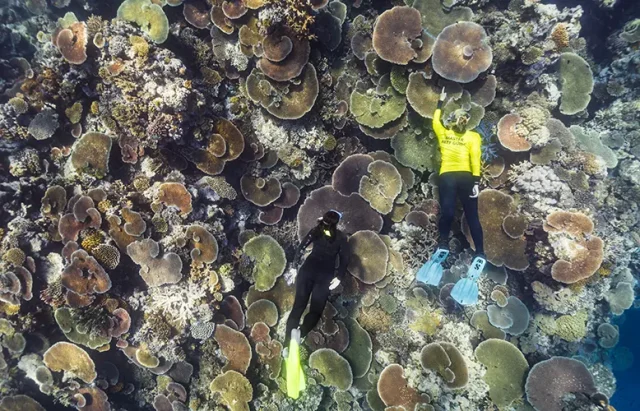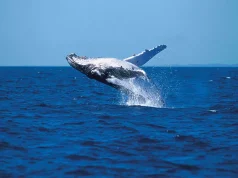
Great Barrier Reef tourism operators, from Mackay to Port Douglas, are breathing a collective sigh of relief after discovering coral colonies at high-value reef visitor sites sustained “little to no damage” in the path of ex-Tropical Cyclone Jasper.
In the lead-up to Christmas, a specialist network of Master Reef Guides, embedded with operators and entrusted by the Great Barrier Reef Marine Park Authority (GBRMPA) to interpret the wonders and challenges facing the World Heritage-listed icon, is abuzz with stories of Reef resilience and hope.
The consensus being, that while some communities north of Cairns are still in cleanup after an extreme flood event, the Reef naturally held its own.
Respected marine biologist, Master Reef Guide, and Cairns local, Eric Fisher, who works as General Manager of GBR Biology (an offshoot of adventure tourism company Experience Co.), is unapologetically upbeat on the specific question of potential positive knock-ons of a low-level cyclone, like Jasper, to Reef health.
“We’ve had a two-degree drop in temperature, so the water is generally around 27°C now, which means this whole event could mitigate fears of predicted bleaching,” says Eric on the back of three days and two nights surveying Moore Reef from his “floating lab” on Reef Magic tourist pontoon, 50km off Cairns.
He added that “really cool winters” generally follow cyclones, in turn boosting spectacular aggregations of big and small fish in shallow reef systems, with a flush of nutrient-rich water from the Coral Sea also providing a smorgasbord for all sorts of marine life at larval phase, leading to “increased recruitment” of species.
“It’s very reminiscent of 2010, when people were predicting a super El Niño and a super bleaching event, and then we ended up with Cyclone Yasi [in early 2011] – and although we had significant coral loss with [category 5] Yasi, the Reef recovered; we didn’t have a bleaching event; and our fish aggregations were amazing that winter, including a lot of species we don’t always see like spangled emperors.”
On 17 December, four days after slow-moving, category 2 Cyclone Jasper made landfall near Wujal Wujal, north of Port Douglas, Eric returned to Moore Reef to discover minimal damage, characterised by “fragmentation”.
“At Moore Reef, we always like to show visitors the Reef’s resilience by taking snorkellers to the outer wall, which, before Yasi, was full of coral, only to be stripped back to bare pavement. It’s since bounced back, unassisted, to 90 per cent coral cover. Cyclone Jasper created some minor fragmentation, primarily involving branching and plate corals, which is not a bad thing.
“These fast-growing corals actually benefit from fragmentation and dispersal to form new colonies. So, you can end up with increased coral cover after these events. In the next couple of years, we know our coral growth is going to go through the roof, particularly in reef lagoons and flats.”
Between leading snorkel tours post Cyclone Jasper, Eric and his team have also aided natural Reef recovery by “flipping corals”, involving simply turning any large fragments found upside down to face the sun for regrowth.
It’s an activity that Master Reef Guides at other sites have also been given GBRMPA’s go-ahead to put into action, as and where needed.
Off Townsville, local dive legend and Master Reef Guide, Paul Crocombe, who founded ecotourism venture, Adrenalin Snorkel and Dive (est. 1987), happily reports “no great impact” surrounding world-acclaimed Museum of Underwater Art (MOUA) installations at John Brewer Reef.
As he explains, MOUA’s award-winning Coral Greenhouse, positioned in a channel behind the reef wall, sustained “no impact at all”. Nor did Ocean Sentinels statues, co-located in an adjacent reef area, where a number of plate corals were tipped over by the cyclone, and quickly righted by Paul and his team.
“It’s a fairly common occurrence in rough weather that exposed plate corals on the tops of reefs or in shallow areas will break off and tip over,” said Paul, who recommenced dive and snorkel tours to the only underwater museum of its kind in the Southern Hemisphere on 17 December.
Three days later, he led dive tours to Australia’s #1 wreck dive, SS Yongala, also finding no impact.
Meanwhile, Cairns-based Master Reef Guide Mel Alps, who works as Training Supervisor with Entrada Travel Group’s suite of Great Barrier Reef operations (including Spirit of Freedom; Tusa Reef Tours; Divers Den; Frankland Islands Reef Cruises; and Spirit of Carins) discovered “an early Christmas gift” upon venturing to her favourite dive site – Troppo’s on Norman Reef – on 22 December.
“Troppo’s is at the top of that reef system, so a lot of past events have given it a hard time, and I went out there expecting to find – and film – damage,” Mel said.
Instead, she “flipped” a few dislodged plate corals, before delighting in the “surprise discovery” that Cyclone Jasper positively changed the face of an area dubbed the “Ski Slope”, by shifting a tonne of sand (likely dumped by Cyclone Yasi), and revealing coral and reef substrate.
“You can now see where all the coral would have been,” Mel said. “There’s a definite line on a boulder coral that is still alive, and with (sand) now gone, the Reef wall has a better chance of regenerating.
“What’s exciting is parrotfish are already moving in and starting to eat algae that’s growing on the rock that’s been revealed.”
On Magnetic Island, located a 20-minute ferry ride off Townsville, Master Reef Guide couple and Aquascene Magnetic Island founders, Stephanie and Adam Hinks, similarly reported no environmental impact to fringing reefs or marine life across their visitor sites.
“It’s all good news for the Reef around Maggie,” said Adam of the region far removed from where the cyclone crossed the coast.
“The only negative impact for us has been cancellations – even today [22 December] we had 12 cancellations on a tour for a boat that only carries 18. So, from that perspective, I think hype about the cyclone, and it possibly crossing anywhere from Bundaberg to Cooktown, was a little over the top.”
In the Whitsundays, Red Cat Adventures co-owner Julie Telford agrees the financial impact of cancellations four days ahead of Cyclone Jasper crossing the coast caused most damage. “The Reef here is spectacular, with no environmental impact,” she said, adding it was also “business as usual” for Wildcat Mackay.
Back at Moore Reef, Eric said visitors on snorkel tours hadn’t even mentioned or noticed Jasper’s impact.
“They’re seeing lots of beautiful, diverse coral coverage and marine life – including big schools of mackerel, lots of turtles, a few reef sharks, eagle rays and even dolphins coming down the wall.
“It’s really only the trained eye that will notice any moved fragments because all the coral colonies are still here… and thriving. Instead, what everyone’s been talking about is the amazing fish life, with aggregations still in place and lots of little wrasses and surgeon fish spawning in the middle of guided tours.
“I watched three surgeon fish species, around five wrasse species and about four parrotfish species all spawning in the same spot and that was replicated three or four times.” Read more about Eric’s work as one of the world’s leading experts on coral reef fish.
Eric also masterminded Australia’s first trial of the Mars Assisted Reef Restoration System (MARRS), aka “Reef Stars”, installed to remedy stubborn rubble patches left in the wake of previous cyclones at Moore Reef, in June 2020, and since rolled out to multiple sites across the Great Barrier Reef.
In cause for celebration, he said all 439 Reef Stars at Moore Reef remained intact post Cyclone Jasper, gloriously hidden beneath flourishing coral gardens purposely plotted with 60 different coral species, collected and attached to hexagonal, sand-coated steel structures as “fragments of opportunity” (naturally dislodged, for example, by parrotfish or storms).
“All of this regeneration work happening on the Reef, also including coral larvae reseeding, crown-of-thorns starfish control and early detection [via environmental DNA detection at planktonic larval stage] has helped increase diversity in coral cover and resilience, so when you do get impact it tends to be less overall.”
Bracing themselves for a “possible crash scene” following a two-week grounding in Port Douglas, Wavelength Reef Cruises owners and marine biologists, John and Jenny Edmondson –
celebrated for co-founding the Reef-wide Coral Nurture Program in partnership with University of Technology Sydney and GBRMPA – returned to survey sites at Opal Reef on 19 December.
“We were worried because one of our sites, Long Bommie, was basically levelled by Cyclone Ita in 2014, but as soon as we got in the water, we could see pretty much all the corals are still there, which is such a massive relief,” Jenny said.
“The only real impact is localised to one small alley in the middle of Long Bommie with fragmentation and plate corals turned upside down, but either side, there’s literally no damage. It won’t take long to recover and replant those fragments, and within a couple of years it will be back to normal.”
Conceived in 2018, the Coral Nurture Program, hailed as a world-first partnership between tourism and science, aims to speed-up the Reef’s natural resilience at high-value visitor sites impacted by stressors like bleaching events and cyclones.
Master Reef Guide Leaundre (Le’a) Dawes-Vaeth oversees stewardship of Coral Nurture Program nurseries at Hastings Reef in her role leading Eco Reef Tours with Passions of Paradise, empowering visitors to “Be a marine biologist for the day”.
For Le’a the most amazing thing about the Great Barrier Reef is its natural resilience – something she shared with a group of visitors from the Netherlands and the United States who joined her first post Cyclone Jasper survey of sites on 21 December.
“There’s very little damage – we found some branching corals that were a bit fragmented and a couple of plate corals flipped upside down, but other than that it was beautiful, and honestly, if you weren’t told there was a cyclone, I really don’t think you would be able to tell.
Master Reef Guide Peter Farrell, who owns and operates Reef Safari Diving, with fellow Master Reef Guide, Julia, providing specialist dive and snorkel encounters for Cruise Whitsundays guests at Hardy Reef (home to Australia’s first underwater accommodation, ReefSuites), says “everything’s really happy on the Reef”, with no negative impacts to report following Cyclone Jasper.
“Everything’s fantastic and at this time of year a whole lot of sergeant major damsel fish undergo a bit of a face-lift,” Peter said. “The males get these big black masks on their faces – which happens every year in November/December – and it’s beautiful.
“I just had a non-swimming, middle-aged Spanish woman, who doesn’t speak a word of English, on a snorkel tour [holding onto a life ring], who had such a beautiful experience that she hugged me three times on the way home and started clapping every time she looked at me.
“That’s why we have the best job in the world, because enabling visitors to see, know and love the Reef means there’s greater likelihood they will leave and make positive environmental changes in their everyday lives.”





